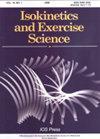手掌持续冷却对热传递和生理的影响
IF 0.7
4区 医学
Q4 ENGINEERING, BIOMEDICAL
引用次数: 0
摘要
背景:过量的热量积累可能是人体运动引起的最危险的应激源。虽然手掌冷却是通过传导来降低体温的,但迄今为止,这种治疗方法从运动中传递的热量尚不清楚。目的:评估手掌持续冷却对传热和生理的影响。方法:31名受试者进行两次锻炼;一个有,一个没有,手掌冷却。训练需要在规定的工作量下进行连续的次最大蹬踏。锻炼时戴手套;在训练开始和结束时,在手套内插入10.6°C的凝胶包。收集心率、耳道和手掌皮肤温度以及手掌的热量传递。数据在运动前、热身结束时、25分钟蹬车和30分钟恢复期间多次获得。结果:耳道温度有显著的治疗效果(手掌冷却;non-palm冷却)。手掌皮肤温度存在交互作用,多次出现较高的非手掌冷却值。相反,传热也会产生相互作用,但手掌冷却在多个时间点上的值明显更高。在手掌冷却训练中,热量传递高出32%。结论:持续的手掌冷却显著提高了亚极限运动的热量传递。本文章由计算机程序翻译,如有差异,请以英文原文为准。
Continuous palm cooling’s effect on heat transfer and physiology
BACKGROUND: Excess heat accrual is perhaps the body’s most dangerous exercise-induced stressor. While palm cooling uses conduction to reduce body temperatures, to date the volume of heat transferred by this treatment resulting from exercise is unknown. OBJECTIVE: Asses continuous palm cooling’s impact on heat transfer and physiology. METHODS: Thirty-one subjects did two workouts; one with, and one without, palm cooling. Workouts entailed consecutive stages of submaximal pedaling against prescribed workloads. Gloves were worn at workouts; for palm cooling 10.6∘C gel packs were inserted into gloves at the workout’s start and conclusion. Heart rate, auditory canal and palm skin temperatures, and heat transfer across the palm were collected. Data were obtained pre-exercise, at the end of a warm-up, and at multiple times during the 25 minutes of pedaling and 30 minutes of recovery. RESULTS: Auditory canal temperatures had a significant treatment effect (palm cooling < non-palm cooling). Palm skin temperature had an interaction, with higher non-palm cooling values at multiple times. Conversely, heat transfer also produced an interaction, but palm cooling had significantly higher values at multiple times. Heat transfer was 32% higher for the palm cooling workout. CONCLUSIONS: Continuous palm cooling produced significantly higher heat transfer from submaximal exercise.
求助全文
通过发布文献求助,成功后即可免费获取论文全文。
去求助
来源期刊

Isokinetics and Exercise Science
医学-工程:生物医学
CiteScore
1.20
自引率
14.30%
发文量
37
审稿时长
>12 weeks
期刊介绍:
Isokinetics and Exercise Science (IES) is an international journal devoted to the study of theoretical and applied aspects of human muscle performance. Since isokinetic dynamometry constitutes the major tool in this area, the journal takes a particular interest in exploring the considerable potential of this technology.
IES publishes studies associated with the methodology of muscle performance especially with respect to the issues of reproducibility and validity of testing, description of normal and pathological mechanical parameters which are derivable from muscle testing, applications in basic research topics such as motor learning paradigms and electromyography. The journal also publishes studies on applications in clinical settings and technical aspects of the various measurement systems employed in human muscle performance research.
The journal welcomes submissions in the form of research papers, reviews, case studies and technical reports from professionals in the fields of sports medicine, orthopaedic and neurological rehabilitation and exercise physiology.
 求助内容:
求助内容: 应助结果提醒方式:
应助结果提醒方式:


